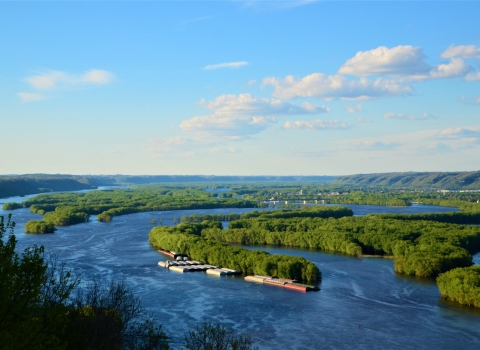WASHINGTON - In his latest effort to increase access to hunting and fishing on public lands and waters, U.S. Secretary of the Interior Ryan Zinke today announced a proposal to open or expand opportunities at 10 national wildlife refuges. If finalized, this would bring the number of refuges where the public may hunt up to 373, and up to 312 where fishing would be permitted.
“I grew up in the mountains of northwest Montana, where I spent my time hunting and fishing on our shared public lands. I was lucky to take my boys out on the same land that my dad and granddad took me,” said Secretary Zinke. “As the steward of our public lands, one of my top priorities is to open up access wherever possible for hunting and fishing so that more families have the opportunity to pass down the heritage. The last thing I want to see is hunting and fishing become elite sports. These ten refuges will provide incredible opportunities for sportsmen and anglers across the country to access the land and connect with the wildlife.”
The U.S. Fish and Wildlife Service manages hunting and fishing programs to ensure sustainable wildlife populations while also offering other traditional wildlife-dependent recreation on public lands, such as wildlife watching and photography. The unparalleled network of 566 national wildlife refuges and 38 wetland management districts means that there is a national wildlife refuge national wildlife refuge
A national wildlife refuge is typically a contiguous area of land and water managed by the U.S. Fish and Wildlife Service for the conservation and, where appropriate, restoration of fish, wildlife and plant resources and their habitats for the benefit of present and future generations of Americans.
Learn more about national wildlife refuge within an hour’s drive of most major metropolitan areas.
“With Secretary Zinke's leadership, the team at the Fish and Wildlife Service is happy to expand hunting and fishing opportunities where they are compatible with wildlife management goals,” said USFWS Acting Director Greg Sheehan. “Sportsmen and anglers play a huge role in the conservation of wildlife and their habitat, so it only makes sense that refuges provide opportunities for folks to get outside to hunt and fish. Refuges provide all Americans with places to hunt, fish, observe the natural world firsthand and experience the great outdoors.”
Hunting, fishing and other outdoor activities contributed more than $144.7 billion in economic activity across the United States according to the USFWS National Survey of Fishing, Hunting and Wildlife-Associated Recreation, published every five years. More than 90 million Americans, or 41 percent of the United States’ population 16 and older, pursue wildlife-related recreation.
Hunting and/or fishing will expand or be opened on the following refuges:
Georgia and South Carolina
- Savannah River National Wildlife Refuge: Expand migratory game bird hunting, upland game and big game hunting. The refuge is already open to migratory game bird hunting, upland game and big game hunting and sport fishing.
Indiana
- Patoka River National Wildlife Refuge: Expand migratory game bird hunting, upland game and big game hunting and sport fishing. The refuge is already open to migratory game bird hunting, upland game and big game hunting and sport fishing.
Minnesota
- Minnesota Valley National Wildlife Refuge: Expand migratory game bird hunting, upland game and big game hunting. The refuge is already open to migratory game bird hunting, upland game and big game hunting and sport fishing.
North Dakota
- Des Lacs National Wildlife Refuge: Open moose hunting for the first time. The refuge is already open to upland game and other big game hunting.
- Upper Souris National Wildlife Refuge: Open moose and turkey hunting for the first time. Expand upland game and big game hunting. The refuge is already open to upland game hunting, other big game hunting and sport fishing.
Oklahoma
- Sequoyah National Wildlife Refuge: Expand upland game and big game hunting. The refuge is already open to migratory game bird hunting, upland game and big game hunting and sport fishing.
Oregon
- Baskett Slough National Wildlife Refuge: Expand migratory game bird hunting. The refuge is already open to migratory game bird hunting.
- Siletz Bay National Wildlife Refuge: Open sport fishing for the first time. The refuge is already open to migratory game bird hunting.
Wisconsin
- Horicon National Wildlife Refuge: Expand migratory game bird hunting and upland game and big game hunting. The refuge is already open to migratory game bird hunting, upland game and big game hunting and sport fishing.
- Fox River National Wildlife Refuge: Expand big game hunting. The refuge is already open to big game hunting.
The USFWS is seeking comments from the public for 30 days regarding information pertaining to the proposed rule. For additional information, go to www.regulations.gov, docket no. FWS-HQ-NWRS-2017-0005. The proposed rule will publish in the Federal Register on August 10, 2017. Comments must be received by September 8, 2017.
More than 50 million Americans visit refuges every year. National wildlife refuges provide vital habitat for thousands of species and access to world-class recreation, from fishing, hunting and boating to nature watching, photography and environmental education. In doing so, they support regional economies to the tune of $2.4 billion dollars per year and support more than 35,000 jobs.
Under the National Wildlife Refuge System Improvement Act of 1997, the Service permits hunting and fishing along with four other types of wildlife-dependent recreation, including wildlife photography, environmental education, wildlife observation and interpretation, when they are compatible with an individual refuge’s purpose and mission. Hunting, within specified limits, is currently permitted on 336 wildlife refuges and 36 wetland management districts. Fishing is currently permitted on 276 wildlife refuges and 33 wetland management districts.



